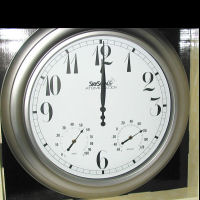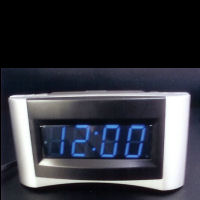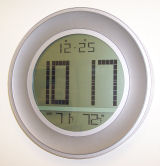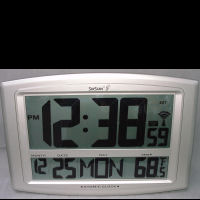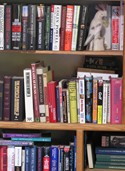|
How They Work
Some manufacturers refer to their radio controlled clocks as "atomic clocks", which isn’t really true. An
atomic clock has an atomic oscillator inside (such as a cesium or rubidium oscillator). A radio controlled clock has a radio
inside, which receives a signal that comes from a place where an atomic clock is located.
In the United States, the signals received by radio controlled clocks originate from NIST Radio Station WWVB, which is located near Fort Collins, Colorado.
WWVB broadcasts on a frequency of 60 kHz. Your radio controlled clock actually has a miniature radio receiver inside, which is
permanently tuned to receive the 60 kHz signal.
The 60 kHz signal is located in a part of the radio spectrum called LF, which stands for low frequency. This
is an appropriate name, because the FM radio and TV broadcasts that we are accustomed to listening to use frequencies thousands
of times higher. The lowest frequency received by any of the other radios in your house is probably 530 kHz, the bottom of the AM
broadcast band. Even that frequency is nearly 10 times higher than the WWVB signal.
At 60 kHz, there isn’t enough room on the signal (bandwidth) to carry a voice or any type of audio
information. Instead, all that is sent is a code, which consists of a series of binary digits, or bits, which have only two
possible values (0 or 1). These bits are generated at WWVB by raising and lowering the power of the signal. They are sent at a
very slow rate of 1 bit per second, and it takes a full minute to send a complete time code, or a message that tells the clock
the current date and time. When you turn a radio controlled clock on, it will probably miss the first time code, so it usually
takes more than one minute to set itself (sometimes 5 minutes or longer) depending on the signal quality and the receiver
design.
Once your radio controlled clock has decoded the signal from WWVB, it will synchronize its own clock to the
message received by radio. Before it does so, it applies a time zone correction, based on the time zone setting that you
supplied. The time broadcast by WWVB is Coordinated Universal Time (UTC), or the time kept at the Prime Meridian that passes
through Greenwich, England. While a few users like their clocks to display UTC (ham radio operators, for example), most prefer to
display local time. This means that the time in your area is corrected by the number of hours shown in the table.
| Time Zone |
Difference from UTC During Standard Time |
Difference from UTC During Daylight Time |
| Pacific |
-8 hours |
-7 hours |
| Mountain |
-7 hours |
-6 hours |
| Central |
-6 hours |
-5 hours |
| Eastern |
-5 hours |
-4 hours |
Once your radio controlled clock has synchronized, it won’t decode the signal from WWVB again for a while.
Some clocks only decode the signal once per day, others do it more often (like every 4 hours or every 6 hours). Those that decode
the signal just once per day usually do it at night, since the signal from WWVB is much stronger once the sun goes down. In
between synchronizations, the clocks keep time using their quartz crystal oscillators. A typical quartz crystal found in a radio
controlled clock can probably keep time to within 1 second for a few days or longer. Therefore, you shouldn’t notice any error
when you look at your clock display, since it will appear to be on the right second, even though it has probably gained or lost a
fraction of a second since the last synchronization.
Where They Work
WWVB radio controlled clocks should be able to work in most places in North America. The red areas on the
coverage maps show where a WWVB radio controlled clock should be able to synchronize. Note that the red
area is largest at night, and smallest in the daytime (click on the map to see a larger image). For example, 0600 UTC is about
midnight in the central United States.
These maps are based on a field strength of 100 microvolts per meter, which in theory should be a large enough
signal for most receivers to work with. In fact, some receivers have much better sensitivity (20 or 30 microvolts per meter).
However, simply having a large signal doesn't mean that the receiver will work. What really matters is the signal-to-noise ratio,
or the size of the signal compared to the size of the electrical noise near the same frequency. Raising the noise level is just
as harmful as reducing the signal level. For example, if the radio controlled clock is near a source of interference (like a
computer monitor) the noise level will increase, and the clock might not be able to synchronize. If the radio controlled clock is
in a building with a metal roof, much of the signal will be blocked. Therefore, the signal level will be reduced, and the clock
might not be able to synchronize.
Therefore, use the coverage maps as a rough indicator only. We have heard from many owners of radio controlled
clocks whose clocks do not work inside the coverage area shown on the maps. This is probably due to a local source of
interference. We have also heard several reports from Alaska that the clocks work fine, even though Alaska is outside the
coverage area shown on the maps. This is probably due to the low amount of radio “background” noise found in a sparsely populated
area.
|

